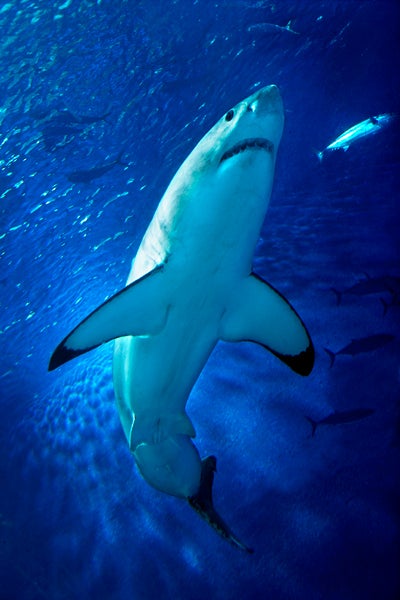Original story by Rob Jordan, Stanford News Service

A juvenile great white shark (Carcharodon carcharias) at the Monterey Bay Aquarium. Photo: Randy Wilder
New research shows that great white sharks power their non-stop journeys of more than 2,500 miles with energy stored as fat and oil in their massive livers. The findings provide novel insights into the biology of these ocean predators.
Great white sharks are not exactly known as picky eaters, so it might seem obvious that these voracious predators would dine often and well on their migrations across the Pacific Ocean. But not so, according to new research by scientists at Stanford University and the Monterey Bay Aquarium.
The researchers' findings, published July 17 in Proceedings of the Royal Society B, reveal previously unknown details of how great white sharks power themselves and stay buoyant on non-stop trips of more than 2,500 miles. The discoveries have potentially broad implications for conservation and management of coastal waters.
"We have a glimpse now of how white sharks come in from nutrient-poor areas offshore, feed where elephant seal populations are expanding – much like going to an Outback Steakhouse – and store the energy in their livers so they can move offshore again," said researcher Barbara Block, a professor of marine sciences and a senior fellow at the Stanford Woods Institute for the Environment. "It helps us understand how important their near-shore habitats are as fueling stations for their entire life history."
Just as bears put on fat to keep them going through long months of hibernation, ocean-going mammals such as whales and sea lions build up blubber to burn on their long migrations. Until now, little was known about how sharks, which carry fat in their massive livers rather than external blubber, make similar voyages.
In a study initiated by a summer project of Stanford undergraduate student Gen Del Raye, researchers first looked at a well-fed juvenile great white shark at the Monterey Bay Aquarium. They documented over time a steady increase in buoyancy as the shark's body mass increased, presumably due to the addition of stored oils in its liver.
The researchers then turned to detailed data records from electronically tagged white sharks free-swimming in the eastern Pacific Ocean. Using these data, which include location, depth and water temperature, the scientists identified periods of "drift diving," a common behavior of marine animals in which they passively descend while momentum carries them forward like underwater hang gliders.
By measuring the rate at which sharks sink during drift dives, the researchers were able to estimate the amount of oil in the animals' livers, which accounts for up to a quarter of their body weight. A quicker descent meant less oil was present to provide buoyancy. A slower descent equated with more oil.
"Sharks face an interesting dilemma," said Sal Jorgensen, a research scientist at the Monterey Bay Aquarium. "They carry a huge store of energy in the form of oil in their massive livers, but they also depend on that volume of oil for buoyancy. So, if they draw on those reserves, they become heavier and heavier."
Buoyancy consistently decreased over the course of each studied shark's migration, indicating a gradual but steady depletion of oil in the liver. In other words, they were primarily running on energy stored up before they embarked on their journeys.
"The most difficult thing about this research was finding a way to bring all of the different sources of data together into a coherent and robust story," said Del Raye.
Part of that story is the importance of calorie-stocked coastal feeding grounds, not just for mammals such as whales, but also for sharks readying for long-distance migrations. Could the same be true for other ocean animals such as sea turtles and a variety of fish? The study may help answer that question too through a novel technological approach that can be applied to ongoing studies of other large marine animals.
![]() Original story by William Rollo, ABC News
Original story by William Rollo, ABC News



